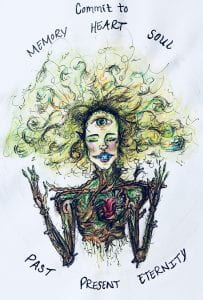Professor Marisol Negrón
Assistant Professor with tenure of American Studies and Latino Studies
Originally published on October 11, 2017 on Avidly, a channel of the Los Angeles Review of Books.
Available at
http://avidly.lareviewofbooks.org/2017/10/11/scholars-for-puerto-rico-relief/
*The fundraising campaign referred to in the essay ended on January 30, 2018.
Two weeks after Hurricane Maria struck Puerto Rico, conditions are still dire and in some regions actually worsening. In the wake of Hurricanes Irma and Maria, approximately 3.5 million residents were without electricity, and without secure access to food, water, medical care, transportation, stable telecommunications, and other necessities. The latest reports show that continued support for Puerto Rico’s residents is needed — particularly as the media’s attention turns elsewhere.
We are scholars committed to supporting Puerto Rico relief and recovery efforts in the aftermath of Hurricanes Irma and Maria. We join others who are increasing awareness of the humanitarian and environmental crisis in Puerto Rico and raising funds for ongoing emergency recovery efforts. All funds raised by Scholars for Puerto Rico will be donated to three community-based organizations who are integral to both immediate and long-term sustainable recovery in Puerto Rico: Casa Pueblo, Organización Pro Ambiente Sustentable, and Taller Salud.
Since the passage of Hurricane Maria, numerous accounts continue to circulate of the widespread destruction of homes, schools, hospitals, and even whole towns in Puerto Rico. Many Puerto Ricans, both there and in the diaspora, remain unable to reach family and friends throughout the territory because vast swaths of Puerto Rico remain without communication. Moreover, reliable news outlets in Puerto Rico estimate that once communication and transportation are reestablished throughout the territory, the official death toll from Hurricane Maria could soar. Still, the U.S. federal government’s response to the crisis in this US territory has been lackluster at best, even though Puerto Ricans are U.S. citizens.
Puerto Rico was a colony of Spain until the end of the Spanish-American War in 1898. Considered a war prize, Puerto Rico, along with several other territories, became a colony of the United States. The Jones-Shaforth Act passed by Congress in 1917 granted Puerto Ricans citizenship. However, those residing in the US territory of Puerto Rico do not enjoy the same civic rights as their mainland counterparts. For example, while residents of Puerto Rico can be drafted into the military, they cannot vote for President and lack voting representation in Congress. Puerto Rico’s limited representation has left the territory with few advocates within the U.S. government to push for meaningful and sustained federal relief during this time of crisis.
Puerto Ricans have long been treated as second-class citizens due to the territory’s colonial status. Hurricane Maria has exposed the continued effects of colonialism on the territory since the early 20th century. The Merchant Marine Act of 1920 (also known as the Jones Act) requires that all goods shipped to Puerto Rico arrive from U.S. ports, on U.S.-constructed ships, with U.S. crews. The Jones Act therefore greatly raises the cost of transporting goods as well as their purchase prices once they arrive in Puerto Rico. In the wake of Hurricane Maria, the Jones Act inflates the time and cost of transporting supplies, personnel, and equipment for Puerto Rico’s recovery efforts from foreign countries. Ships carrying aid to Puerto Rico from countries like the Dominican Republic and Cuba, which have both offered help, cannot deliver aid directly to a port in the territory. They would instead have to travel to a port on the U.S. mainland before transporting aid to their Caribbean neighbor. On September 28, the Trump administration suspended the Jones Act for ten days to facilitate hurricane relief. However, with recovery efforts expected to take months, a reimposition of the Jones Act will obstruct the ability of aid to reach Puerto Rico in a timely fashion.
Since Hurricane Maria, the federal fiscal control board installed by the US government in 2016 to oversee the territory’s finances has only authorized $1bn to fund the recovery. This is nowhere near the amount Puerto Rico will need to not only rebuild, but create a more sustainable and disaster resistant infrastructure. The federal government has also failed to announce a moratorium on Puerto Rico’s debt repayment or consider any form of debt forgiveness in light of Maria’s catastrophic effects.
The physical and technological infrastructural collapse that followed Hurricane Maria was enabled by more than a decade of austerity measures imposed by the local and federal governments to deal with Puerto Rico’s mounting debt. These austerity measures starved public utilities of the funds needed to make repairs and upgrades and left Puerto Rico’s infrastructure particularly vulnerable. Puerto Rico cannot be rebuilt on a foundation of austerity and colonial neglect.
We must support and aid community-based organizations in Puerto Rico working to rebuild the territory amidst structural inequalities of colonialism and inadequate support from the federal government. In addition to the most basic supplies, Puerto Rico needs billions of dollars to rebuild its infrastructure, homes, and institutions like hospitals, government buildings, and schools. Community-based organizations like Casa Pueblo, Organización Pro Ambiente Sustentable, and Taller Salud are central to the recovery and rebuilding of Puerto Rico.
- Casa Pueblo, an organization dedicated to community empowerment and the protection of natural and cultural resources;
- Organización Pro Ambiente Sustentable (OPAS), an environmental organization whose programming efforts focus on education about and management of sustainable resources; and
- Taller Salud, which works to improve the lives of girls and women, particularly in under-resourced communities.
We stand in solidarity with Puerto Rico and all those committed to not only rebuild but transform Puerto Rico with long-term sustainable recovery and recuperation initiatives …
Update 2/1/2018:
The initial campaign raised $28,756. A second campaign raised an additional $8,254 to support relief and recovery efforts of the three organizations below:
- IDEBAJO, a consortium of organizations in the Jobos Bay region that advocates for environmentally preferred alternatives in community development;
- Comedores Sociales de Puerto Rico, a grassroots food distribution initiative that began in 2013 in response to the economic crisis; and
- PECES, an organization that fosters social, economic, and educational development in under-resourced communities.
For additional information, we recommend the Puerto Rico Syllabus, which contains materials for thinking critically about the Puerto Rico debt crisis and the destruction caused by Hurricane Maria, the storm’s aftermath, and what the storm revealed about the colonial relationship, debt and austerity, and the unequal vulnerability of Puerto Rico’s residents. The syllabus also includes additional teaching tools and media resources for use in classrooms.
Scholars for Puerto Rico*
*Scholars for Puerto Rico is not a group, but rather an effort to raise funds for recovery efforts in the territory. Several scholars worked collaboratively to bring this fundraising campaign to fruition: Frances Aparicio (Northwestern University), Arlene Dávila (New York University), Zaire Dinzey-Flores (Rutgers University), Lorena Estrada-Martínez (University of Massachusetts Boston), Lawrence La Fountain-Stokes (University of Michigan), Marisol LeBrón (Dickinson College), Marisol Negrón (University of Massachusetts Boston), Jade Power-Sotomayor (University of Washington Bothell), Lorna Rivera (University of Massachusetts Boston), Petra Rivera-Rideau (Wellesley College), and Wilson Valentín-Escobar (Hampshire College).
Scholars for Puerto Rico is in partnership with Scholars for Haiti and thanks Yveline Alexis, Nadège T. Clitandre, Marlene Daut, Darlene Dubuisson, April Mayes, and Kyla Wazana Tompkins for their support.
Authorship note: Professor Negrón is one of several scholars who worked collaboratively to organize the effort to raise funds for community organizations engaged in relief and recovery efforts after Hurricane Maria. Scholars for Puerto Rico is not a group, but rather an effort to raise funds for recovery efforts in the territory. Several scholars worked collaboratively to bring this fundraising campaign to fruition: Frances Aparicio (Northwestern University), Arlene Dávila (New York University), Zaire Dinzey-Flores (Rutgers University), Lorena Estrada-Martínez (University of Massachusetts Boston), Lawrence La Fountain-Stokes (University of Michigan), Marisol LeBrón (Dickinson College), Marisol Negrón (University of Massachusetts Boston), Jade Power-Sotomayor (University of Washington Bothell), Lorna Rivera (University of Massachusetts Boston), Petra Rivera-Rideau (Wellesley College), and Wilson Valentín-Escobar (Hampshire College).
Originally published on October 11, 2017 on Avidly, a channel of the Los Angeles Review of Books. Available at http://avidly.lareviewofbooks.org/2017/10/11/scholars-for-puerto-rico-relief/










You must be logged in to post a comment.